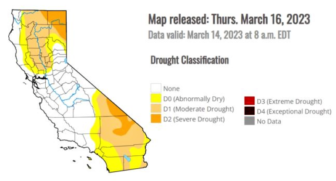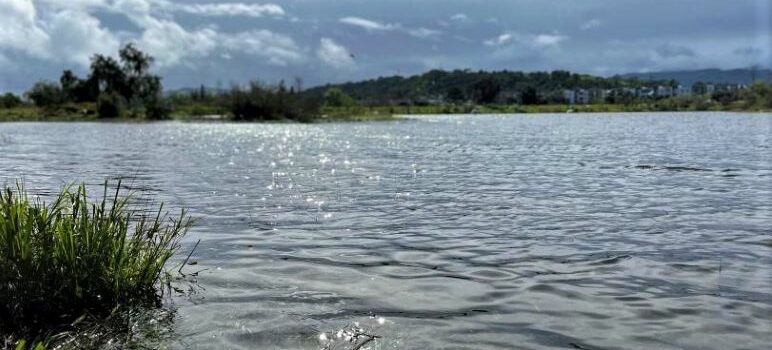With the Sierra Nevada smothered in snow, large swaths of the Central Valley under water and many Californians weary of water, state officials announced today that they are lifting some drought-related provisions on water use.
“Our water supply conditions have improved markedly,” Secretary of Natural Resources Wade Crowfoot said in a statement today.
The state is rescinding its request for voluntary 15% water conservation statewide, which was issued in July 2021, and instead, Crowfoot said, shifting to an approach of making conservation a “way of life.”
“We need to maintain our vigilance,” he said. “It’s not about going back to normal anymore. It’s really adjusting to a new normal.”
Some of the state’s emergency provisions were ended and some were left in place. Wasteful uses of water, such as hosing down sidewalks and watering ornamental grass on commercial property, remain banned, according to state officials.
The state, however, is ending its requirement that local water agencies implement Level 2 drought contingency plans, which are locally written water use regulations— such as limits on watering lawns — that are invoked during water shortages.
For the first time in more than three years, Santa Clara County is no longer in any of the five U.S. Drought Monitor categories. In just a few months’ time, Valley Water reports, moving from being classified as being in an extreme drought to being out of drought.

California Drought Map, March 2023
CalMatters
“Record-setting atmospheric rivers this year have boosted reservoir levels locally and statewide, adding to our groundwater recharge and building up historic levels of snowpack in the Sierra Nevada,” Valley Water Board Chair John L. Varela said in a statement this week.
The Sierra Nevada snowpack is a critical piece of Santa Clara County’s water supply, as half the water used locally originates outside the county and is imported, according to the water district. Because of the reconstruction of Anderson Dam, Santa Clara County is increasing its reliance on “imported water,” Varela said. “While our county is out of drought, some of the areas that provide us with imported water are not.”
“We know droughts will become more frequent and more severe in the future, and the next drought may be just around the corner,” he said. “That’s why we encourage everyone in Santa Clara County to make water conservation a way of life.”
In total, 81 drought-related provisions have been enacted statewide since April 2021. Just 33 remain in place, said Gov. Gavin Newsom at a press briefing today.
State officials also announced today a large increase in the amounts of water that local suppliers will get from the State Water Project, increasing from 35% announced last month to 75% of requested supplies. The water is provided to 750,000 acres of farmland and 27 million people, mostly in Southern California.
The announcements come as some of the state’s reservoirs near capacity, with some of the state’s largest expected to fill by late spring. And the snowpack of the Sierra Nevada, nearing record levels in the southern portion of the range, continues to grow.
When Newsom issued his voluntary conservation target almost two years ago, many water experts said Newsom should have made it mandatory, as former Gov. Jerry Brown did during the previous drought. They also criticized him for failing to reduce use by farmers, who consume 80% of the state’s delivered water supply.
State officials say even though the 15% target was voluntary, it worked. However, the data does not back that up: Californians used 6% less water from July 2021 through December 2022 compared to 2020 — falling far short of Newsom’s 15% goal.
Heather Cooley, director of research at the Pacific Institute, an Oakland water supply thinktank, said California must not relax its ethos of water conservation.
In spite of wet weather, the state’s largest water supply — its groundwater basins — remain depleted.
“Even though reservoirs are recovering, groundwater aquifers remain depleted. The Colorado River — a major water source for Southern California — is also facing a massive deficit,” Cooley said. “The reality is we don’t have water to waste in California. We need to continue investing in water efficiency to prepare for a hotter, drier future and more intense droughts.”
Mike McNutt, spokesperson for the Las Virgenes Municipal Water District in Los Angeles County, said the retraction of the conservation target “sends the wrong message” to the public.
“Why put out messaging that says something different, that says, ‘You can conserve if you want to, but you don’t need to’?” said McNutt, whose district serving 75,000 people is totally reliant on water from the state aqueduct.
“The next drought is certainly just around the corner,” he added.
Californians did cut their average water use by 600,000 acre-feet in almost two years. That’s almost two-thirds the volume of Folsom Reservoir and enough water to serve 1.2 million households in a year.
Crowfoot stressed that the drought is not over, noting that drought status “is not a completely binary situation.” In some parts of the state, drought conditions have dramatically eased, but not in others. Crowfoot said the Klamath River basin and the region of Southern California that relies on Colorado River water continue to face “acute water shortages.”
Thousands of households lack drinking water due to depleted groundwater basins , which have been overdrafted for decades and experts agree they will not rebound in a single rainy winter.
Joaquin Esquivel, chair of the State Water Resources Control Board, said the hope is that cities “are not just rebounding” to old ways of water use.
“Conservation remains a priority,” Crowfoot added.
Michael Anderson, a climatologist with the California Department of Water Resources, said snowpack is at 278% of normal, with another storm system expected to hit the North Coast and move inland and south from there, starting Monday. The system, he said, will deliver a relatively cold storm originating in the Gulf of Alaska, unlike some recent blasts of tropical moisture. This means it will drop more snow in the mountains.
“Not massive accumulations, but could be locally heavy,” he said.
Alastair Bland is a reporter with CalMatters. San Jose Inside contributed local data for this report.

